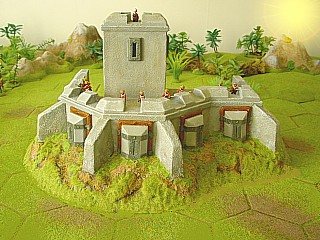
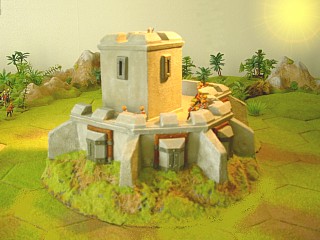
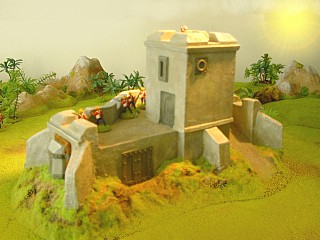
Front
view of a standard C.A.C. The central "keep" housed the offices
and the living quarters of the British administrator.
Side
view of a standard C.A.C. clearly showing three of the six sponsons.
Indistani troops are manning the battlements.
Indistani troops are manning the battlements.
Back
view of a standard C.A.C. Note the steel entrance gate in the wall and
the steel door in the "keep". Both could be firmly locked from
the inside
Lord
Alan Hamilton took control over the British colonies in Afriboria after
what became known as the "Black Summer", during which no less
than 20 British settlements all over Afriboria were overrun by natives.
All settlers and troops occupying these posts were slaughtered without
mercy, causing such a row in England that Lord Hamilton's predecessor
was forced to resign. Even before leaving England to take up his new post,
Alan Hamilton was well aware of the fact that many more outposts would
be wiped out unless he would find a solution to this problem. The "struggle
for Afriboria" was at its height and he did not have enough troops
to protect all new (or older, for that matter...) settlements properly.
Lord Hamilton had formerly not only been Inspector General of HM Prisons
but was also a keen student of (feudal) history and was therefore familiar
with both prison buildings and medieval castles. This combined knowledge
gave birth to the idea of the "Colonial Administrative Centre",
a building that would be the focus point of each new (larger) British
settlement. The C.A.C. would provide enough space to shelter the settlers
in times of unrest and only need a relatively small contingent of troops
to defend. In case the battlements would be overrun, the occupants would
still be safe inside behind steel doors, normally impregnable to native
warbands. All C.A.C.'s would both be modular and (basically) identical.
The buildings would be constructed in reinforced concrete, recently invented
by WB Wilkinson. C.A.C.'s were numbered in Roman numerals (I, II, III,
IV etc), but generally given the name of the settlement they belogned
to.
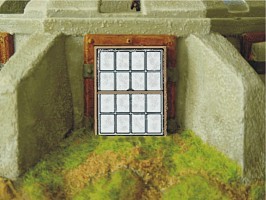
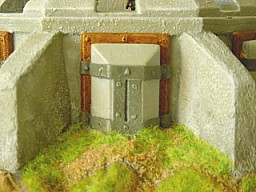
Teams
of Royal Engineers officers were trained to construct these centres and
with a large labour force drawn from the Nile and Indistani regions the
number of C.A.C.'s was to grow swiftly. Though the "keep" always
looked forbidding, in times of peace the sponson windows made the C.A.C.
look like a manor house, but in times of unrest they could be swiftly
blocked by concrete elements with fire slits. C.A.C.'s were either built
on top of a well or were equipped with huge water tanks. When under siege,
messages could get out by pigeons. A popular saying amongst colonial troops
was "We joined the Army to see the world. What did we see?...
The C.A.C.!"
"Peacetime
look" of sponson window.
"Wartime
look" with concrete element in place.